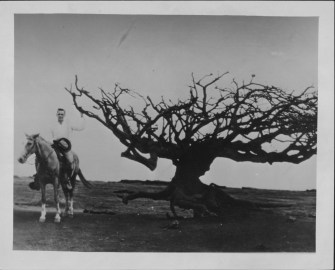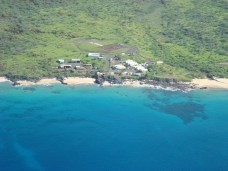“Early the next morning, with a pleasant breeze from the NE, we stood over towards the east point of Mororoi (Molokai.) … we sailed to the westward … In this the land rises rather abruptly from the sea, towards the lofty mountains in the center of the east part of Morotoi …”
“… and though the acclivity was great, yet the face of the country, diversified by eminences and vallies, bore a verdant and fertile appearance. It seemed to be well inhabited, in a high state of cultivation, and presented not only a rich but a romantic prospect.” (Captain George Vancouver, March 19, 1793)
“… a beautiful deep valley….watered by a large and delightful stream of fresh water which falls from the mountains…in two grand and beautiful cataracts one of which rushes over a perpendicular decent of more than five hundred feet into a deep…and crystal lake”.
“The stream which issues from the lake … is so situated as to be easily drawn off by sluices into the taro plots…. the valley is principally laid out in these small rectangular plots …” (Hitchcock, 1833; NPS)
In 1877, a native Hawaiian described Hālawa “as a very fertile valley, with wild fruits, mountain shrimps, and much water in the streams…. There were nine hundred and thirteen taro patches and with the hundred and nine others that I hadn’t counted, they totaled a thousand and thirty-two patches. Most of the land is covered in taro”. (NPS)
“The glimpses of Molokai which one obtains from a steamer’s deck while passing to Honolulu from San Francisco or in passing to and from Maui (along its south shore,) give the impression that the island is bleak, mountainous and desolate.”
“Skirting its (north) shores on the Hālawa, Wailua and Pelekunu sides on Wilder’s fine steamer Likelike, gives a far different picture. For miles sheer precipices rise from the sea and tower 1,500 feet into the air.”
“Now and then, and sometimes in groups, beautiful waterfalls are seen on the face of the cliff, now falling in clear view for a couple of hundred feet, now hidden under denses masses of foliage, only to reappear further down, another silvery link In the watery thread which ends In a splash and scintillating mist in the breakers below.” (Hawaiian Gazette, March 31, 1905)
The windward valleys developed into areas of intensive irrigated taro cultivation and seasonal migrations took place to stock up on fish and precious salt for the rest of the year. Kalaupapa was well known for its bountiful ʻuala (sweet potato) crops and its fine-grained, white salt which was preferred over that from the salt ponds of Kawela and Kaunakakai. (Strazar)
John FG Stokes, who was Curator of Polynesian Ethnology at Bishop Museum, was sent to Molokai in 1909 to survey the remains of the ancient Hawaiian temples (heiau) found there. Stokes recorded thirteen medium-sized heiau distributed along the lower slopes and two large luakini heiau.
Molokai used to be referred to as ʻAina Momona (the bountiful land,) reflecting the great productivity of the island and its surrounding ocean.
It is about 38-miles long and 10-miles wide, an area of 260-square miles, making it the 5th largest of the main Hawaiian Islands (and the 27th largest island in the US.)
The island was formed by two volcanoes, East and West, emerging about 1.5-2-million years ago. The cliffs on the north-eastern part of the island are the result of subsidence and the “Wailua Slump” (a giant submarine landslide – about 25-miles long that tumbled about 120-miles offshore – about 1.4-million years ago.)
Hālawa Valley is the easternmost valley at the edge of Molokai’s north shore; four other major valleys span the coastline, from Hālawa westward toward Kalaupapa: from east to west they are Papalaua, Wailau, Pelekunu and Waikolu.
Archeological surveys indicate that by the 1300s, Hālawa Valley’s population had expanded inland, and small irrigation systems were developed along the streams.
By the 1600s, an extensive taro irrigation system dominated the valley’s settlement pattern. At that time, the lower valley was entirely covered in large rectangular fields watered by long irrigation ditches (taro loʻi made up about 55-acres of land.)
Hitchcock who established the first permanent Mission Station at Kaluaʻaha in 1832, gave a census figure of 6,000 for the island. (Strazar)
These early counts were generally taken in the field by both native school teachers and missionaries. During this period, the Reverends Hitchcock and Smith preached once a week at seven different stations from Kamaloʻo to Hālawa, and in 1833 they estimated the population of the entire island to be about 3,300. (Strazar)
Follow Peter T Young on Facebook
Follow Peter T Young on Google+
Follow Peter T Young on LinkedIn
Follow Peter T Young on Blogger




























































